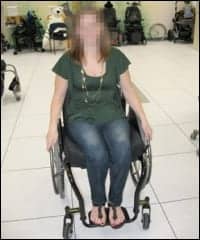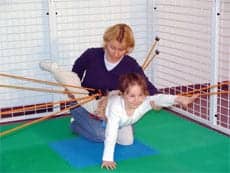
Chair width old: Seat width too wide.

Chair width new: Appropriate seat width.
Recently, there has been much discussion about the materials that are used to make manual wheelchairs. While this is an important issue and one that needs to be discussed further, there has not been enough discussion about how the fit and setup of the wheelchair affect function. The best, lightest-weight, tremor-dampening, high-strength, long-lasting wheelchair is no better than a depot wheelchair if the chair is set up poorly.
Research has shown that improper wheel position can cause a number of repetitive stress injuries. Rotator cuff tears and elbow and wrist injuries are common in wheelchair users and need to be prevented when possible. Clearly, preserving upper limb function over a lifetime of wheelchair use is very important and should be something that all seating professionals strive to do.
The issue that is frequently missed when prescribing a wheelchair is how the fit affects a person’s simple everyday function. Many wheelchair professionals focus on fixed rules that they are taught, and, as a result, they unknowingly prescribe wheelchairs that limit their patients’ function. The goal of this article is to discuss four areas where function can be improved by selecting the proper fit of the wheelchair.
CHAIR WIDTH
The width of the chair is made up of several components including seat width, rear wheel spacing, and camber. The narrower the overall width, the narrower the doors the person can traverse. Considering many homes and businesses are not truly accessible, just 2 inches may make a difference between someone being able to access a bathroom and having to use a commode chair in their bedroom.
Seat width is one of the most important measures and one of the most frequent areas of improper chair setup. Therapists and suppliers are frequently taught that a patient should have 2 inches of seat width greater than their widest point (hip or thigh width). In pediatrics, this is even worse, as people sometimes select 3 to 4 inches to accommodate for potential growth.
Some accommodation should be made for potential weight gain in people with new injuries. However, this should be done with a great deal of thought. If the person was thin and active prior to injury, chances are high that they will remain thin and active after injury, so 2 inches of seat width is not likely to be needed. With more experience following this population post-injury, professionals should learn who is most likely to experience weight gain and be able to judge how to select an appropriate seat width.

Front seat angle old: Front seat angle too small.
Another population that frequently receives chairs that are too wide are children, as people worry about growth. Children with disabilities such as cerebral palsy grow more in depth than they do in width. So, if a chair is 4 inches too wide when provided, it is likely going to be 3.5 inches too wide when the chair is ready to be grown due to a child’s increase in height. With this population, it is important to remember that most chairs can be grown through some mechanism and do not need to fit in width for 5 years.

Front seat angle new: Appropriate front seat angle.
Making chairs too wide leads to difficulty accessing the wheels because people have to abduct their shoulders and cannot rest their arms in a neutral position. It also decreases stability because it allows, and even can cause, too much lateral movement in the chair when the person performs functional activities. Both of these issues lead to discomfort and decreased function.
A chair that is about the same width as the person allows the individual to feel more connected to the chair, so they can propel and move more effectively. Wheelchairs users say that more tightly fit chairs allow them to maneuver the chair without even thinking about it. People also report less fatigue propelling than when they used a wider chair.
The rear wheel spacing and the camber also affect the overall width of the chair. The closer the rear wheels are to the seat, the narrower the chair will be. The more camber on the chair, the faster the wheels will turn and the better they will maneuver. However, this makes the chair wider, so depending on the person’s environment and life needs, they may need to sacrifice either function or accessibility.
CHAIR DEPTH

Seat depth old: Seat depth too deep.
Chair depth is comprised of the actual seat depth, the rear wheel position, the front frame angle, and the center of gravity. These adjustments can affect posture, stability, and accessibility. The longer the overall chair is, the less maneuverable it will be.
Properly adjusted seat depth allows for correct support under the thighs and buttocks. When the seat depth is too long, the seat hits the person in the knees and can cause the individual to go into a posterior pelvic tilt. This poor seating position can compromise sitting stability and can cause the person to round their shoulders forward and propel in a detrimental position for their upper extremities. A seat depth that is too short is not as common a problem in this type of chair. However, when it does occur, it causes increased pressure under the buttocks and thighs and it can result in a feeling of instability.
When possible, a tighter front-frame angle is beneficial to many aspects of function. For people with tight hamstrings, it can allow them to sit with a neutral pelvic tilt, so they can sit upright to propel and be the most functional. For someone with good trunk function and sitting balance in the wheelchair, accessing objects in front of them is the most functional and appropriate way to complete tasks. A tight angle can allow them to access objects in front of them such as countertops, microwave ovens, and desks. Without a tight front-frame angle, many people have to complete activities from the side, which can result in injury due to poor biomechanical positions that are assumed when the trunk is rotated and the extremities are reaching across the body.
The center of gravity of a wheelchair can significantly affect function. Frequently, professionals select a center of gravity that is too far back. The further back the center of gravity, the more stable the chair. However, this can make wheel access difficult as the person must reach back instead of down to contact the handrim. In improving stability, it decreases the person’s ability to perform skills such as wheelies or to safely navigate uneven surfaces, which allows people to propel efficiently. For the best function, the center of gravity should be as far forward as the person can use functionally, without risk of injury. For new wheelchair users, this needs to be assessed every few months as the person learns to use the chair, becomes more stable, and can safely use a larger center of gravity. This improves ease of propulsion on all surfaces and can improve accessibility.

Seat depth new: Appropriate seat depth.
SEAT HEIGHTS
The difference between the front and rear seat height is the slope. Seat slope can affect sitting stability and transfers. Some individuals cannot propel with a flat seat. For individuals with limited trunk control, higher seat slopes can improve stability by allowing gravity to hold the person in the system. People with good trunk control frequently like at least a small amount of slope, as it allows them to rest against the backrest easier. The only potential downside to slope is that it can negatively affect transfer ability. Individuals who have upper extremity weakness may not be able to independently transfer out of a seat with a significant amount of slope because they are going against gravity. Accommodations such as a slide board may be necessary to assist them. Every effort should be made to assess trunk strength and sitting balance to ensure the correct seat slope for maximizing sitting stability and function.
AESTHETICS

To read more on this topic, visit “Mobility Issues: An Update,” “Striking a Balance” and “2010 Wheelchair Cushion Showcase.”
The final area that is just as important as the others is aesthetics. When people feel good about themselves, they are more functional and productive. They want to interact with others. The chair is part of their overall appearance, and it should basically disappear underneath them. When the chair is properly adjusted to maximize function, the chair is not visible and the person is able to interact with others, without a focus on their wheelchair. Even people who like bright colors, differently styled wheels, or other customization of the chair look better and higher-functioning when their chair is fit properly.
Improving the fit of the wheelchair to increase function for people who use wheelchairs is an important area of focus and can be achieved if function is discussed and assessed during the provision process and following delivery. Following up with patients months/years after delivering wheelchairs will assist in learning the positive and negative results of the wheelchair process. By paying attention to patients’ reports about their activities and limitations, professionals can ensure they are maximizing their patients’ function and make necessary changes if they are not.
Lauren E. Rosen, PT, MPT, MSMS, ATP, a 14-year industry veteran, is the program coordinator for the Motion Analysis Center at St Joseph’s Children’s Hospital, Tampa, Fla. She performs 3-D gait analysis and oversees a pediatric and adult seating and positioning clinic. For more information, contact .





